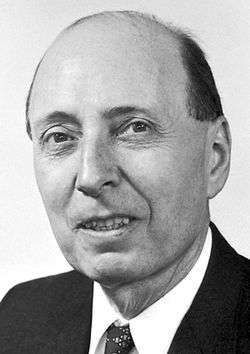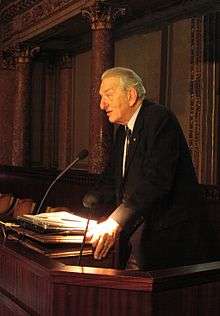The Martians (scientists)
"The Martians" were a group of prominent Hungarian scientists of Jewish descent (mostly, but not exclusively, physicists and mathematicians) who emigrated to the United States in the early half of the 20th century.[1] They included, among others, Theodore von Kármán, John von Neumann, Paul Halmos, Eugene Wigner, Edward Teller, George Pólya, John G. Kemeny and Paul Erdős. They received the name from a fellow Martian Leó Szilárd, who jokingly suggested that Hungary was a front for aliens from Mars. In an answer to the question of why there is no evidence of intelligent life beyond earth despite the probability of it existing, Szilárd responded: "They are already here among us – they just call themselves Hungarians."
List of 'The Martians'

Others
Dennis Gabor (Gábor Dénes), Ervin Bauer, Róbert Bárány, George de Hevesy (Hevesy György Károly), Nicholas Kurti, George Klein and perhaps his wife, Eva Klein as well (Kürti Miklós), Michael Polanyi (Polányi Mihály) and Marcel Riesz are also sometimes named as 'Martians', though they did not emigrate to the United States. However, others not of Jewish descent are often mentioned in connection with 'The Martians', including Loránd Eötvös, Kalman Tihanyi, Zoltán Lajos Bay, Victor Szebehely, Albert Szent-Györgyi and Georg von Békésy, as well as Maria Telkes, the only woman.
History

During and after World War II, many Central European scientists immigrated to the United States, mostly Jewish refugees fleeing from Nazism or Communism.[4] Several were from Budapest, and were instrumental in American scientific progress (e.g., developing the atomic bomb).
But in June 1948, I had to resign from the Institute because the political situation no longer permitted them to employ an outspoken anti-Marxist as I had been. Yet Anne [Harsanyi's later wife] did go on with her studies. But she was continually harassed by her Communist classmates to break up with me because of my political views, but she did not. This made her realize, before I did, that Hungary was becoming a completely Stalinist country, and that the only sensible course of action for us was to leave Hungary.
In October 1956, Hungary rebelled against Soviet rule, but the uprising was soon overwhelmed by drastic means demanding many lives. Budapest was demolished again and the future seemed cloudy. In November and December 1956, about 200,000 Hungarians, mainly young people, fled the country. With my family and with most of my group, we have also decided to go on this journey and look for a new life in the West.
Origin of the name

Since they all spoke English with a strong accent (made famous by horror actor Bela Lugosi), they were considered outsiders in American society. The Hungarian scientists were seemingly superhuman in intellect, spoke an incomprehensible native language, and came from a small obscure country. This led to them being called Martians, a name they jocularly adopted.
The joke was that Hungarian scientists are actually descendants of a Martian scout force which landed in Budapest around the year 1900, and later departed after the planet was found unsuitable, but leaving behind children by several Earth women, children who all became the famous scientists. John von Neumann used a number of facts as mock evidence to support this claim, such as the close geographic proximity of the Martian's birthplaces; the well-traceable career path, which started with an interest in chemistry, led the individual in question to German universities where he moved towards physics, at which point the Martian left Europe for the United States.
The original story from György Marx's book The Martians:
The universe is vast, containing myriads of stars...likely to have planets circling around them.... The simplest living things will multiply, evolve by natural selection and become more complicated till eventually active, thinking creatures will emerge.... Yearning for fresh worlds...they should spread out all over the Galaxy. These highly exceptional and talented people could hardly overlook such a beautiful place as our Earth. – "And so," Fermi came to his overwhelming question, "if all this has been happening, they should have arrived here by now, so where are they?" – It was Leo Szilard, a man with an impish sense of humor, who supplied the perfect reply to the Fermi Paradox: "They are among us," he said, "but they call themselves Hungarians."
When the question was put to Edward Teller – who was particularly proud of his monogram, E.T. (abbreviation of extraterrestrial)[2] – he looked worried, and said: "Von Karman must have been talking."[6]
According to György Marx, the extraterrestrial origin of the Hungarian scientists is proved by the fact that the names of Leo Szilárd, John von Neumann and Theodore von Kármán cannot be found on the map of Budapest, but on the Moon are craters bearing their names:[2]
There is also a crater on Mars named after Von Kármán.
References
- ↑ M. Whitman (2012) The Martian's Daughter: A Memoir, University of Michigan Press.
- 1 2 3 A marslakók legendája – György Marx
- ↑ Akikre büszkék lehetünk – Bornemissza Péter Gimnázium
- 1 2 John C. Harsanyi – Biographical – www.nobelprize.org
- ↑ GEORGE A. OLAH – OLÁH GYÖRGY – Fizikai Szeme, 1995/2
- ↑ Macrae, Norman (1992). John von Neumann: The Scientific Genius Who Pioneered the Modern Computer, Game Theory, Nuclear Deterrence, and Much More. Pantheon Press. p. 33. ISBN 0-679-41308-1.
Further reading
- György Marx (2000). A Marslakók Érkezése (Arrival of the Martians). Hungary: Akadémiai Kiadó. p. 456. ISBN 963-05-7723-2.
- Hargittai, István (2006). The Martians of Science: Five Physicists Who Changed the Twentieth Century. USA: Oxford University Press. p. 376. ISBN 978-0-19-517845-6.